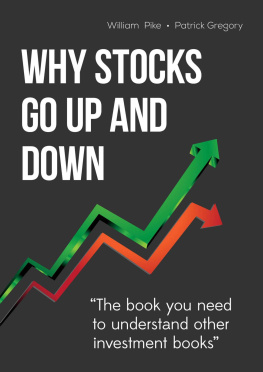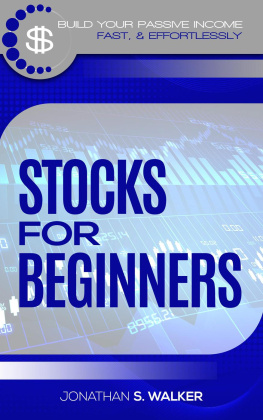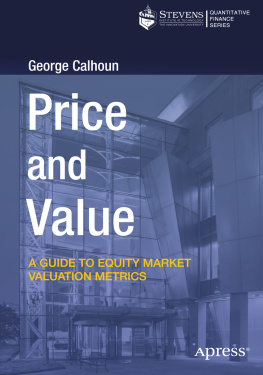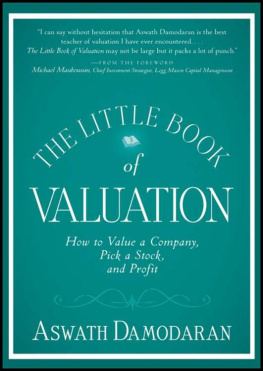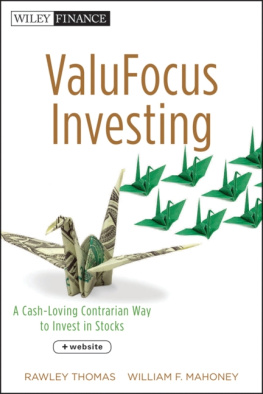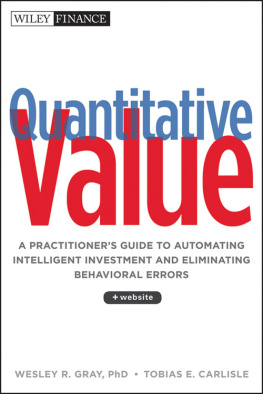Why Stocks Go Up and Down
William Pike and Patrick Gregory
Bill Pike Books
September 2013
www.WhyStocksGoUpandDown.com
WHY STOCKS GO UP AND DOWN
by WILLIAM H. PIKE and PATRICK C. GREGORY
Copyright 2013 William H. Pike
ISBN: 978-0-9892982-1-6
LCCN: 2013908933
Cover Design: Leo Pike
Production assistance: Peter Rovick, Jeanne Cooper
All rights reserved. The text, graphs, charts, tables and figures in this publication, or any part thereof, may not be reproduced or transmitted in any form or by any means, electronic or mechanical, including photocopying, recording, scanning, storage in an information retrieval system, or otherwise, without prior written permission of the publisher.
This publication is sold with the understanding that the authors are not providing investment advice. The financial data interpretation and valuation methods discussed herein are just a few of the many ways to look at investments. Any of the investment analyses or valuation methods presented herein may not be applicable to individual securities, and may require further investment analysis in order to make an informed investment decision. Readers are encouraged to get other opinions and to consult an investment professional before investing.
First Kindle Edition
Prepared by Vally Sharpe
Table of Contents
A company is founded and basic financial statements and terms are introduced.
The company raises new equity money from private investors. The company incorporates and formalizes its ownership equity accounts.
The basic terminology of borrowing is explained, and some new terms are added to the balance sheet.
Twenty-one commonly watched ratios are discussed, including profitability ratios, financial condition ratios and liquidity ratios. The importance of earnings-per-share is introduced.
What it means to go public and why a company does so. The difference between a primary offering, a secondary offering, and an initial public offering is covered.
Earnings dilution, a key concept, is presented, and we also look at stock splits and the process of going public.
We see how a company wishing to raise new money chooses between a stock offering, which may dilute earnings, and a bond offering, which will lower earnings as a result of the higher interest expense.
A bond is basically a loan. There are differences between bonds that affect their value to investors. The difference between coupon yield, current yield, and yield to maturity is presented. An understanding of bond priorities and ratings, and other features, will help investors distinguish among bonds as investments.
Bond prices and yields respond to changes in prevailing interest rates and changes in issuer creditworthiness. We look at the U.S. Treasury yield curve, and other yield curves. The spread between yield curves will help determine when bond prices are high or low.
Additional bond features, such as call and refunding provisions, and covenants will provide a more complete understanding of bonds. Zero coupon bonds and resets are explained.
Convertible bonds are like other bonds except they can also be converted into common stock. Here we learn how that conversion feature gives these bonds very different investment characteristics, as well as impacting the earnings share reported on the income statement. Basic and diluted earnings are explained.
We see how a preferred stocks fixed dividend and other characteristics make it quite different from common stock.
We learn how to convert a convertible preferred stock, and see its impact on earnings-per-share. Hybrid, or trust preferred securities, are introduced. They have features of both preferred stock and bonds.
How companies account for the wearing out of their assets directly impacts the earnings they report to stockholders. It also allows for an understanding of the important concept of cash flow.
A lot of accounting and investment terminology presented in this chapter will increase the readers sophistication and ability to participate in more advanced investment discussions.
Cash flow is not the same as earnings. Understanding the difference will help investors interpret financial statements, and therefore improve their ability to identify both attractive stocks and companies that may be headed for trouble. Looking at a companys sources and uses of cash flow can reveal a very different picture than just looking at earnings.
The cost of a companys inventory is not as easily determined as one might guess. The LIFO or FIFO assumptions that a company makes in costing its inventory will impact its earnings in the current year and in the future. We will see when inventory write downs may indicate trouble and when they may present a buying opportunity.
The price/earnings ratio is the primary measure that investors use in valuing stocks. We look at the price/earnings ratio in a number of ways, and also look at other valuation ratios: price/cash-flow, price/sales, price/earnings power, and enterprise value/EBITDA. The material in this chapter has helped clear up a lot of our students misunderstandings about stock prices.
In the final chapter, we apply the concepts covered throughout the book to the stock of Abbott Labs. This real world example will help readers appreciate the nuances of applying the analytical framework to a publicly traded company.
TO THE READER
The fundamental knowledge
all investors need.
There are many popular books about investing which try to convey wisdom without first conveying adequate knowledge. Why Stocks Go Up and Down does just the opposite. It presents the basic fundamental knowledge that all investors need. This will enable you to get more value from other books which deal with specific aspects or approaches to investing. Why Stocks Go Up and Down goes well beyond other introductory investment books. It will not insult your intelligence. In fact, it will go into more detail in some areas than you may need, but by doing so, the major concepts should stay with you, and you will not find yourself having more questions than you started with.
The book is the outgrowth of introductory investment courses we have taught at the college level and through professional organizations such as the Boston Security Analysts Society for more than 20 years. Our students are newcomers to the investment business who have had little or no experience with accounting, finance, or the stock market. The book has evolved to provide themand other interested investorswith the fundamentals needed for successful investing.
Part 1 introduces the basic concepts of business ownership and financial statement analysis. The emphasis on accounting may not seem relevant at first, but stock prices are directly related to financial statements. To ignore this would be an oversimplification, and would leave readers with major gaps in their knowledge. Part 1 also covers the process of going public and the difference between primary and secondary equity stock offerings. This section will clear up many common misconceptions.
Part 2 is about bonds and preferred stock (which is quite different from common stock). To understand a company and its stock price behavior, it is important to understand all the instruments a company can use to raise capital. It is, however, possible to skip over Part 2 without losing the continuity of the other parts of the book. In fact, many readers skip from Part 1 to Part 4 in their first time through the book.
Part 3 explains more fully how income statements and balance sheets relate to stock prices. When you understand concepts such as write-offs, or the difference between earnings and cash flow, you will be better able to understand stock price behavior.

